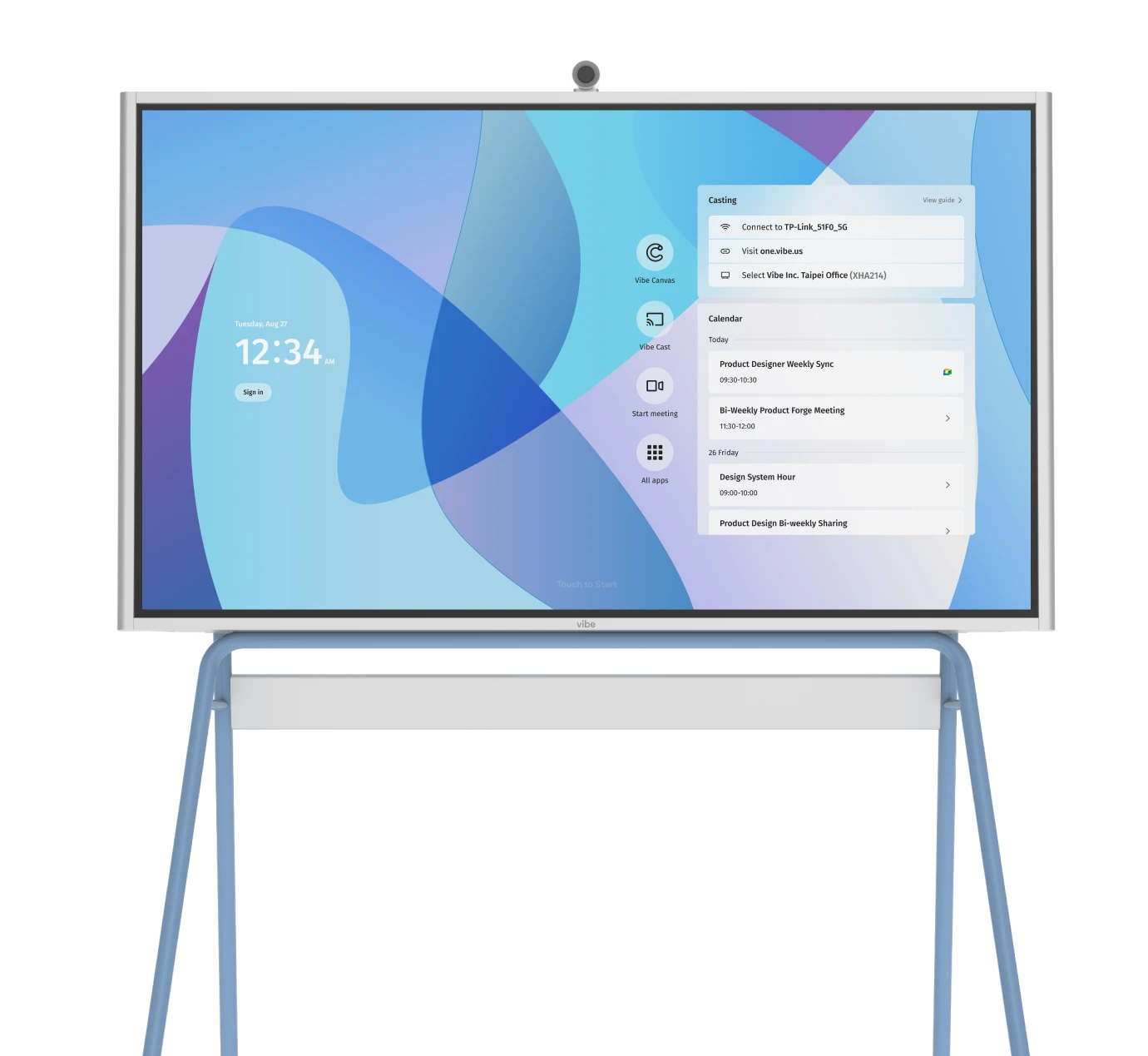In modern work environments with many workplaces operating remotely or in a mixed model, effective collaboration has become more crucial than ever before. Gone are the days when teams could simply gather around a physical office whiteboard to brainstorm ideas or plan projects. The digital transformation of workplaces has necessitated sophisticated tools that can bridge geographical gaps while maintaining—and even enhancing—team productivity and creativity.
As we move further into 2025, collaboration software has evolved from a nice-to-have to an absolute necessity. Whether your team is distributed across different time zones or working under the same roof, the right collaboration tools can transform how you communicate, create, and complete projects together.
What is Team Collaboration Software?
Team collaboration software encompasses a range of digital tools designed to help teams work together effectively regardless of their physical location. These platforms create a centralized digital environment where team members can communicate, share files, manage tasks, and collaborate on projects in real-time.
Modern collaboration software serves as the digital equivalent of a conference room equipped with a smart workspace, enabling teams to brainstorm, plan, execute, and track progress all in one place. It eliminates the barriers of distance and time, allowing for both synchronous and asynchronous collaboration that keeps projects moving forward around the clock.
At its core, collaboration software aims to align workers by providing support to groups of individuals working toward common objectives. From simple messaging apps to comprehensive project management platforms, these tools create a cohesive digital ecosystem where information flows freely and work progresses smoothly.
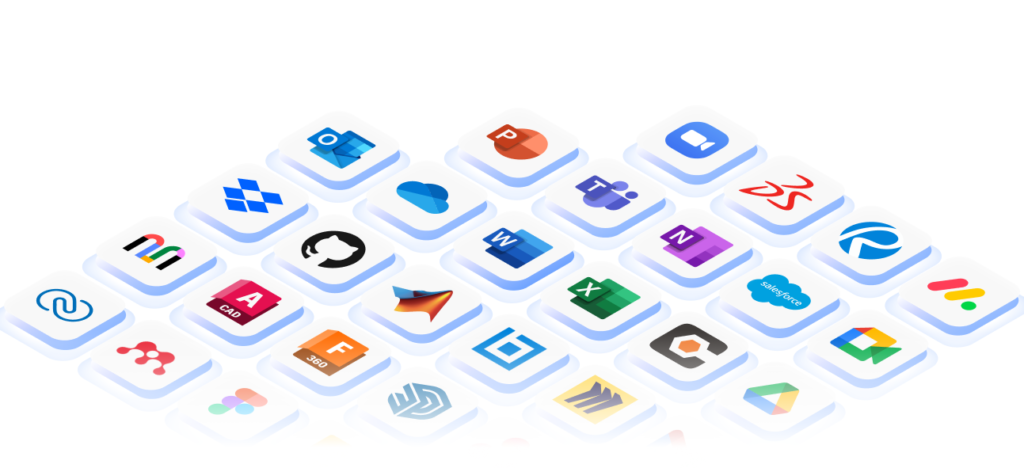
Why You Should Be Using Collaboration Software
The shift toward collaboration software isn’t just a trend—it’s a response to the fundamental changes in how we work. With remote and hybrid work models becoming the norm, businesses need robust tools to keep their teams connected and productive. Beyond accommodating remote work, collaboration software addresses common workplace challenges like information silos, chaotic workflows, and miscommunication. By providing a central platform for knowledge sharing and project coordination, these tools help teams overcome the limitations of traditional email-based communication and fragmented document storage.
Research shows that good collaboration significantly improves both employee productivity and business outcomes. Studies have found that the majority of workers at collaborative organizations feel well-prepared to adapt to emergent business challenges—up to four times higher than those at organizations with weak collaboration practices.
Features of Effective Collaboration Software
The best collaboration platforms combine multiple functionalities to create a seamless working environment. While specific features vary between tools, certain core capabilities define truly effective collaboration software. Let’s explore the essential features that power productive teamwork in the digital age.
Task Management
Effective collaboration software provides tools for creating, assigning, and tracking tasks. Key capabilities include customizable workflows, dependency mapping, and visualization through Kanban boards or Gantt charts. These ensure everyone understands their responsibilities and deadlines, keeping projects on track.
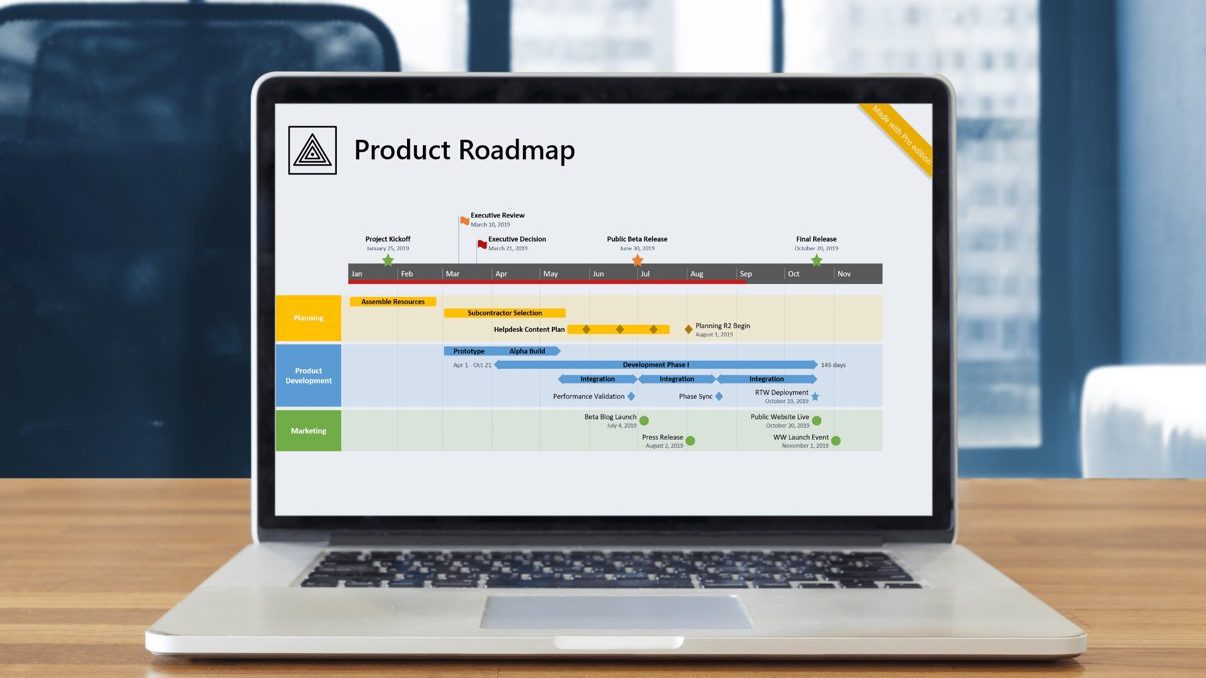
Real-time Editing and Updating
Real-time editing allows multiple team members to work on the same document or project simultaneously, eliminating version confusion. Modern platforms ensure all edits are immediately reflected across all instances—particularly valuable for time-sensitive deliverables requiring multiple stakeholders’ input.
Group Chat and Messaging
Group chat features enable teams to exchange messages and files in real time, reducing traditional email delays. Advanced features include threaded conversations, searchable history, and organized discussions by topic. Many platforms integrate voice and video calling for seamless communication transitions.
Integration Capabilities
Top collaboration platforms connect with other software in your technology stack, including email, calendars, cloud storage, and CRM systems. These integrations create a cohesive ecosystem where information flows seamlessly between tools, eliminating constant application switching.
User-friendly Interfaces
Intuitive interfaces encourage adoption and ensure teams leverage their collaboration tools effectively. The best platforms balance comprehensive functionality with clean design, offering customization options while maintaining a consistent structure that’s easy to learn and use.
Benefits of Using Collaboration Software
Implementing the right collaboration tools can transform how your team works together, delivering benefits that extend far beyond simple convenience. From boosting productivity to fostering innovation, collaboration software creates the conditions for teams to perform at their highest level.
Improved Productivity and Efficiency
Collaboration software boosts productivity by centralizing communication, file sharing, and project management. This eliminates time wasted switching between applications or searching for information. Research shows that two-thirds of workers waste 60 minutes daily toggling between apps; collaboration platforms reduce this digital friction.
These tools also streamline decision-making processes. With access to collective intelligence and searchable records of past decisions, teams can make informed choices more quickly, avoiding delays associated with traditional approval hierarchies.
Heightened Communication
Collaboration software provides multiple channels for clear, contextual exchanges, from real-time messaging to video conferencing and document annotation. This ensures information flows freely between team members, preventing misunderstandings and creating an accessible organizational memory.
For remote or distributed teams, these tools are particularly valuable in fostering connection and shared purpose. Features like status updates and virtual "water cooler" channels help maintain the social aspects of teamwork in digital environments.

Smoother Project Management
Collaboration software streamlines project management by providing clear visibility into task status, resource allocation, and timeline progress. Interactive project management boards allow teams to visualize workflows, identify potential issues early, and adjust plans as needed.
Automated notifications and reminders keep everyone accountable without constant check-ins, freeing project managers to focus on strategic direction rather than day-to-day coordination.
Boosted Creativity and Innovation
By breaking down departmental silos and facilitating diverse contributions, collaboration platforms create an environment where innovation can flourish. Digital whiteboards and brainstorming tools enable teams to capture and develop ideas together, regardless of physical location.
For organizations with remote team members, these tools ensure that distance doesn’t diminish creative input. They make it possible for everyone to participate fully in ideation and problem-solving sessions, bringing diverse perspectives to challenges and opportunities.
Common Types of Team Collaboration Tools
The collaboration software landscape encompasses a variety of specialized tools designed to address different aspects of teamwork. Understanding the distinct categories can help you identify which types of tools will best serve your team’s specific needs.
Communication Tools
Communication tools enable team members to exchange information and maintain connections regardless of location. Features include messaging, group chats, video conferencing, and comment threads.
Popular tools create organized conversation spaces by topic or project, with a searchable history ensuring important information remains accessible. For remote teams, these platforms serve as digital equivalents of office interactions, supporting both work discussions and social connection.
Project Management Tools
Project management tools help teams plan, execute, and track work across multiple initiatives. They provide features for task assignment, deadline setting, progress tracking, and resource allocation.
Visual interfaces like Kanban boards and Gantt charts help teams understand project status at a glance and identify potential bottlenecks. These tools ensure that everyone understands how their work contributes to broader objectives and maintains alignment around shared goals.
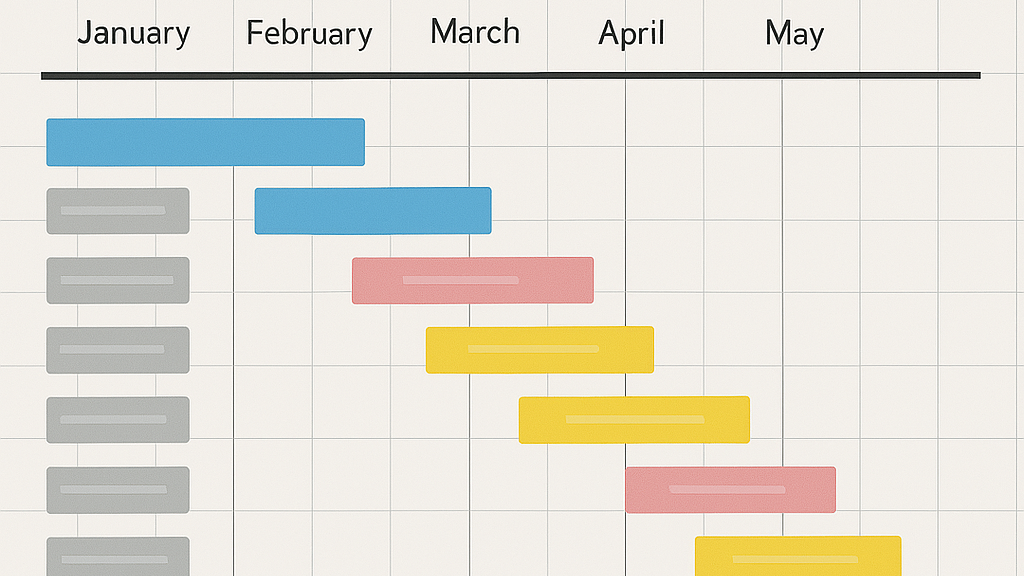
Document Management Tools
Document management tools enable teams to create, edit, store, and share files in a centralized location with version control and collaborative editing capabilities.
By eliminating multiple document versions and email attachments, these tools ensure teams always have access to current information. The ability for multiple users to work simultaneously accelerates review cycles and improves deliverable quality.
Online Whiteboarding Tools
Digital whiteboarding tools recreate the experience of gathering around a physical dry erase board, allowing teams to visualize ideas collaboratively. These platforms provide canvas space where team members can add text, drawings, and sticky notes.
For creative processes like brainstorming and problem-solving, online whiteboarding provides a visual dimension that text-based collaboration often lacks. The ability to save sessions creates a persistent record of creative thinking teams can build upon.
Cloud Storage Tools
Cloud storage tools provide secure, accessible repositories for team files and documents. These platforms enable teams to store, organize, and share files without the limitations of physical storage or email attachments.
By centralizing file storage in the cloud, these tools ensure that team members always have access to the information they need, regardless of device or location. Advanced search capabilities make it easy to find specific files even within large document libraries.
Calendar Sharing Tools
Calendar sharing tools help teams coordinate schedules, plan meetings, and manage time effectively. These platforms typically include features for viewing team availability, scheduling events, and sending meeting invitations.
By making schedules visible to the entire team, these tools eliminate the back-and-forth typically required to find meeting times that work for everyone. Integration with other collaboration platforms ensures that relevant documents and discussion threads are linked directly to calendar events.

Workflow Automation Tools
Workflow automation tools help teams streamline repetitive processes and reduce manual coordination. These platforms typically include features for creating automated workflows, setting up approval processes, and triggering actions based on specific events.
By reducing the administrative burden of routine tasks, workflow automation tools free team members to focus on higher-value work. The consistency provided by automated processes also reduces errors and ensures that important steps aren’t overlooked.
Integration with other collaboration tools allows automated workflows to span multiple platforms, creating end-to-end processes that move work forward with minimal manual intervention.
10 Top Team Collaboration Software Tools
With countless collaboration tools on the market, identifying the best options for your team can be challenging. Here’s a curated list of the top collaboration platforms for 2025, each offering unique strengths to support different aspects of teamwork.
1. Slack
Slack has established itself as the gold standard for team messaging and communication. Its channel-based structure allows teams to organize conversations by topic, project, or department, creating a searchable archive of organizational knowledge.
Beyond basic messaging, Slack offers robust integration capabilities, connecting with thousands of other tools to create a centralized hub for teamwork. Features like threaded replies, rich search functionality, and customizable notifications help teams stay organized even as conversation volumes grow.
For distributed teams, Slack’s huddles feature provides a lightweight way to have voice conversations without the formality of scheduled meetings, recreating the spontaneous interactions that happen naturally in physical workspaces.
2. Microsoft Teams
Microsoft Teams offers a comprehensive collaboration environment that combines chat, video conferencing, file sharing, and integration with the broader Microsoft 365 ecosystem. This tight integration makes Teams particularly valuable for organizations already invested in Microsoft tools like Word, Excel, and SharePoint.
The platform’s meeting capabilities include features like breakout rooms, live transcription, and background blur, creating a professional environment for virtual collaboration. The ability to create team workspaces with dedicated channels, shared files, and integrated apps helps keep project information organized and accessible.
For organizations with complex security and compliance requirements, Teams offers enterprise-grade controls that ensure collaboration remains secure even when involving external partners or sensitive information.
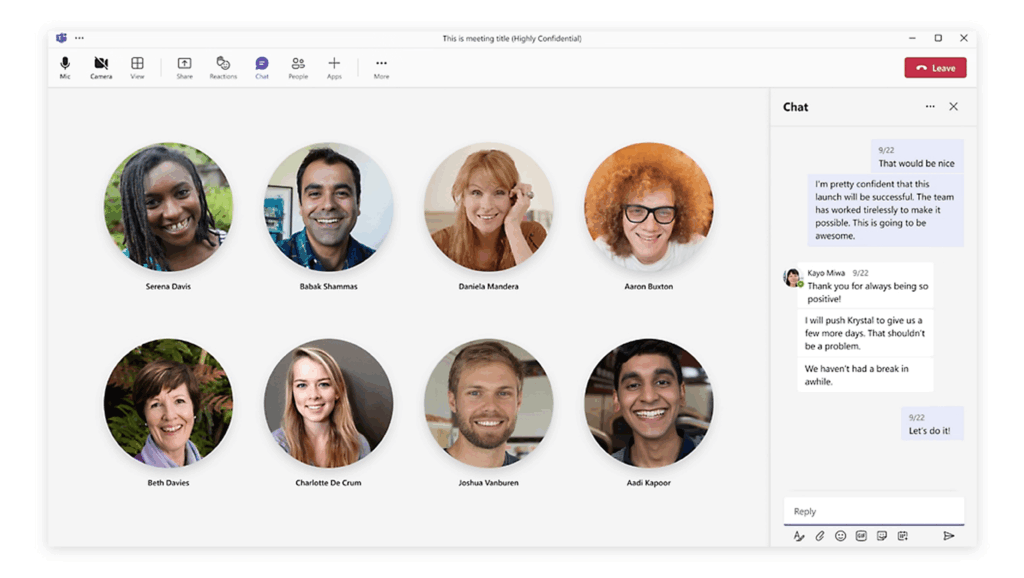 Microsoft Teams collaboration software interface.
Microsoft Teams collaboration software interface.3. Asana
Asana is a powerful project management platform that helps teams organize tasks, set priorities, and track progress toward goals. Its flexible interface allows teams to view work as lists, boards, timelines, or calendars, accommodating different project types and personal preferences.
Features like custom fields, dependencies, and milestones help teams manage complex projects with multiple moving parts. The ability to create templates for recurring workflows ensures consistency and reduces setup time for new initiatives.
Asana’s reporting capabilities provide insights into team capacity, project status, and potential bottlenecks, helping managers allocate resources effectively and keep work moving forward smoothly.
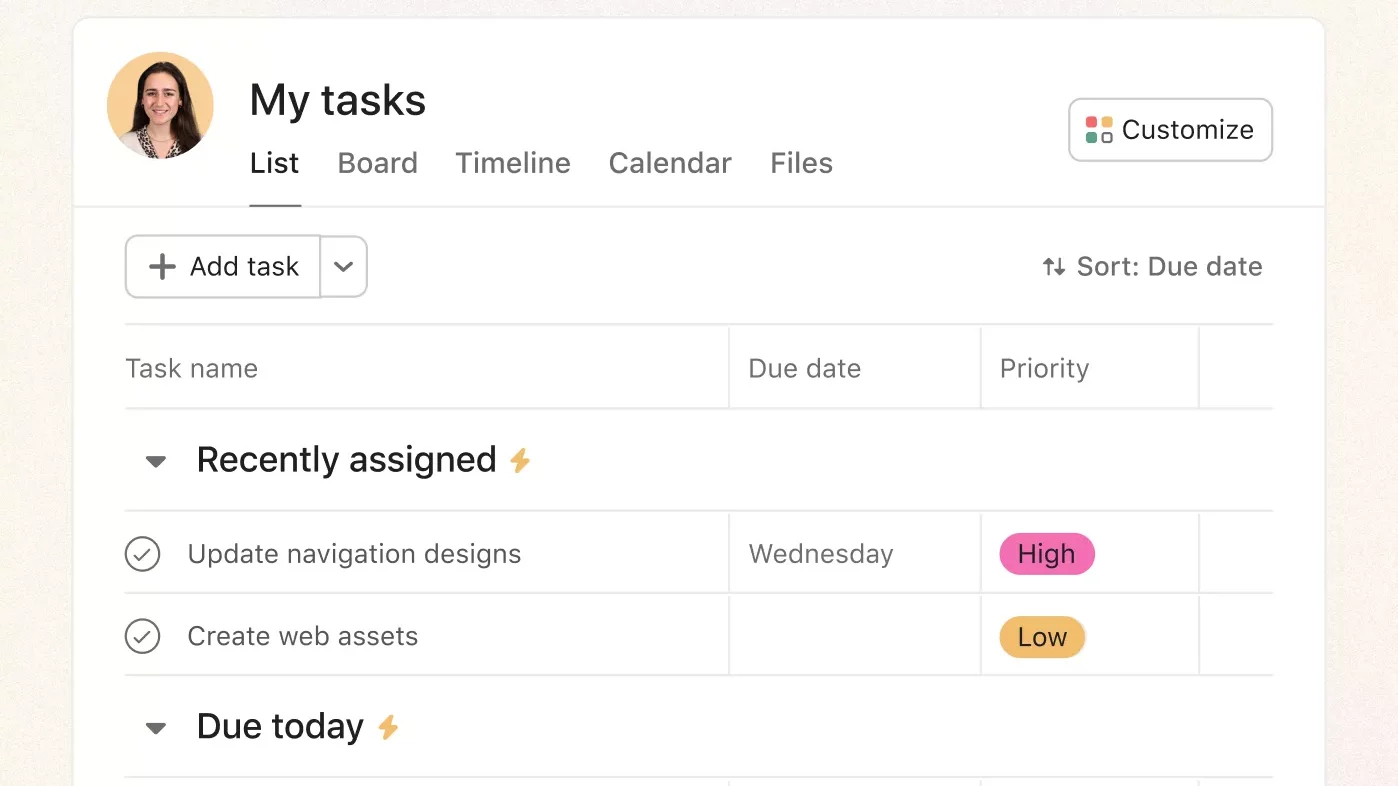 Asana project management dashboard interface.
Asana project management dashboard interface.4. Trello
Trello offers a visual, intuitive approach to project management based on the Kanban methodology. Its board-based interface uses cards and columns to represent tasks and workflow stages, creating a clear picture of project status at a glance.
The platform’s simplicity makes it accessible to team members with varying levels of technical expertise, while power-up integrations allow for customization to support complex workflows. Features like checklists, due dates, and attachments ensure that cards contain all the information needed to complete tasks successfully.
For teams that value visual organization and straightforward task management, Trello provides an approachable entry point to structured collaboration without overwhelming complexity.
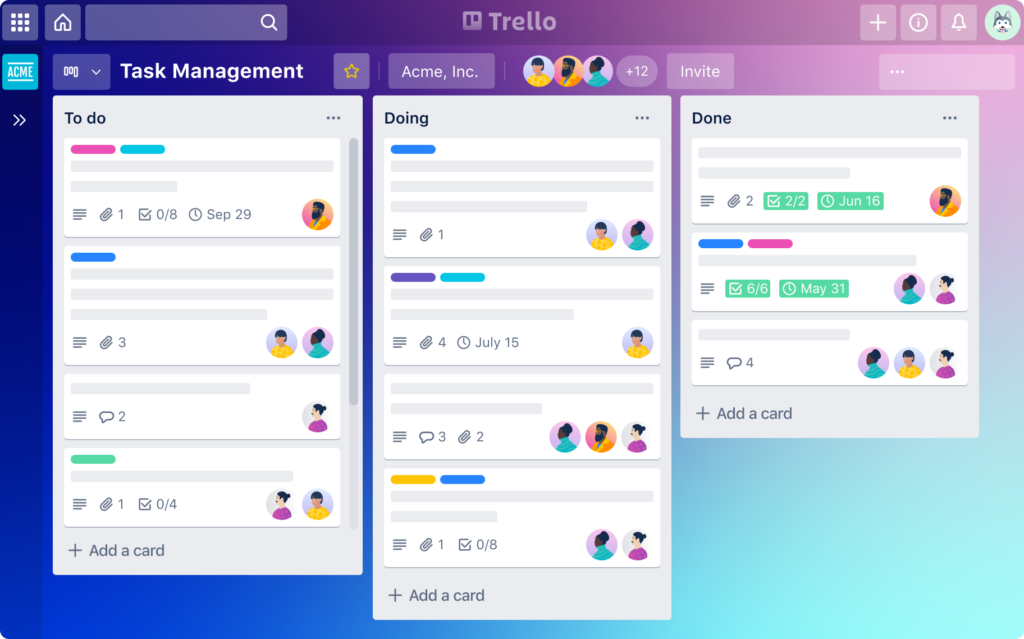 Trello project management dashboard interface.
Trello project management dashboard interface.5. Miro
Miro is an online collaborative whiteboard platform that provides infinite canvas space for visual thinking and creative collaboration. Its versatile toolkit includes sticky notes, shapes, connectors, and templates for everything from mind mapping to user story mapping.
The platform’s real-time collaboration features allow multiple team members to work on the same board simultaneously, creating an interactive environment for brainstorming and planning. Integration with video conferencing tools enables teams to combine visual collaboration with face-to-face discussion.
For design thinking, strategic planning, and other visually-oriented work, Miro recreates the dynamic energy of gathering around a physical whiteboard while adding digital capabilities that extend what’s possible in analog environments.
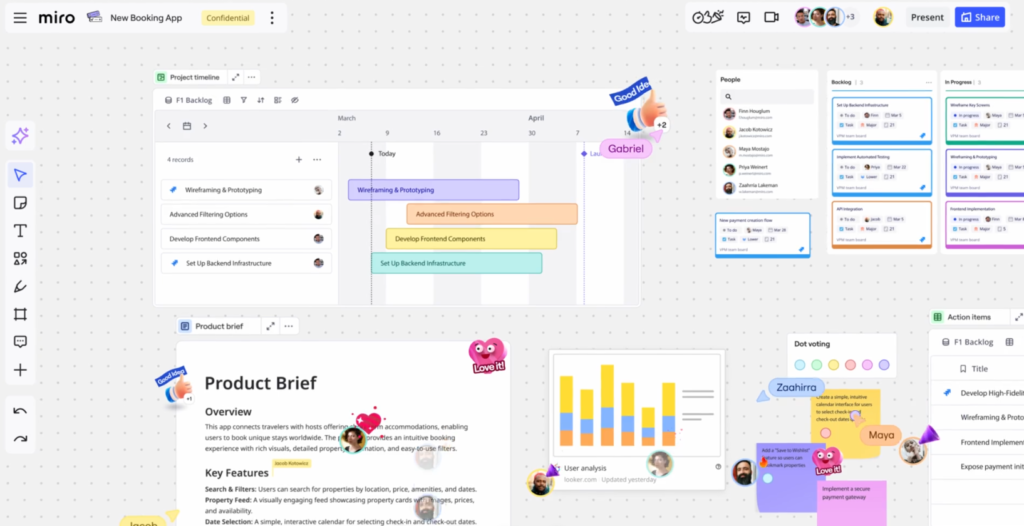 Miro online collaborative whiteboard interface.
Miro online collaborative whiteboard interface.6. Google Workspace
Google Workspace (formerly G Suite) offers a comprehensive set of cloud-based productivity and remote collaboration tools, including Gmail, Drive, Docs, Sheets, Slides, and Meet. The platform’s strength lies in its seamless integration between these various components and its emphasis on real-time collaboration.
Google’s real-time editing capabilities allow multiple users to work on the same document simultaneously, with changes appearing instantly and a revision history that makes it easy to track contributions or revert to previous versions. The comment and suggestion features facilitate feedback and discussion directly within documents.
For teams that value simplicity and accessibility, Google Workspace provides a familiar, user-friendly environment that requires minimal training while supporting sophisticated collaboration.
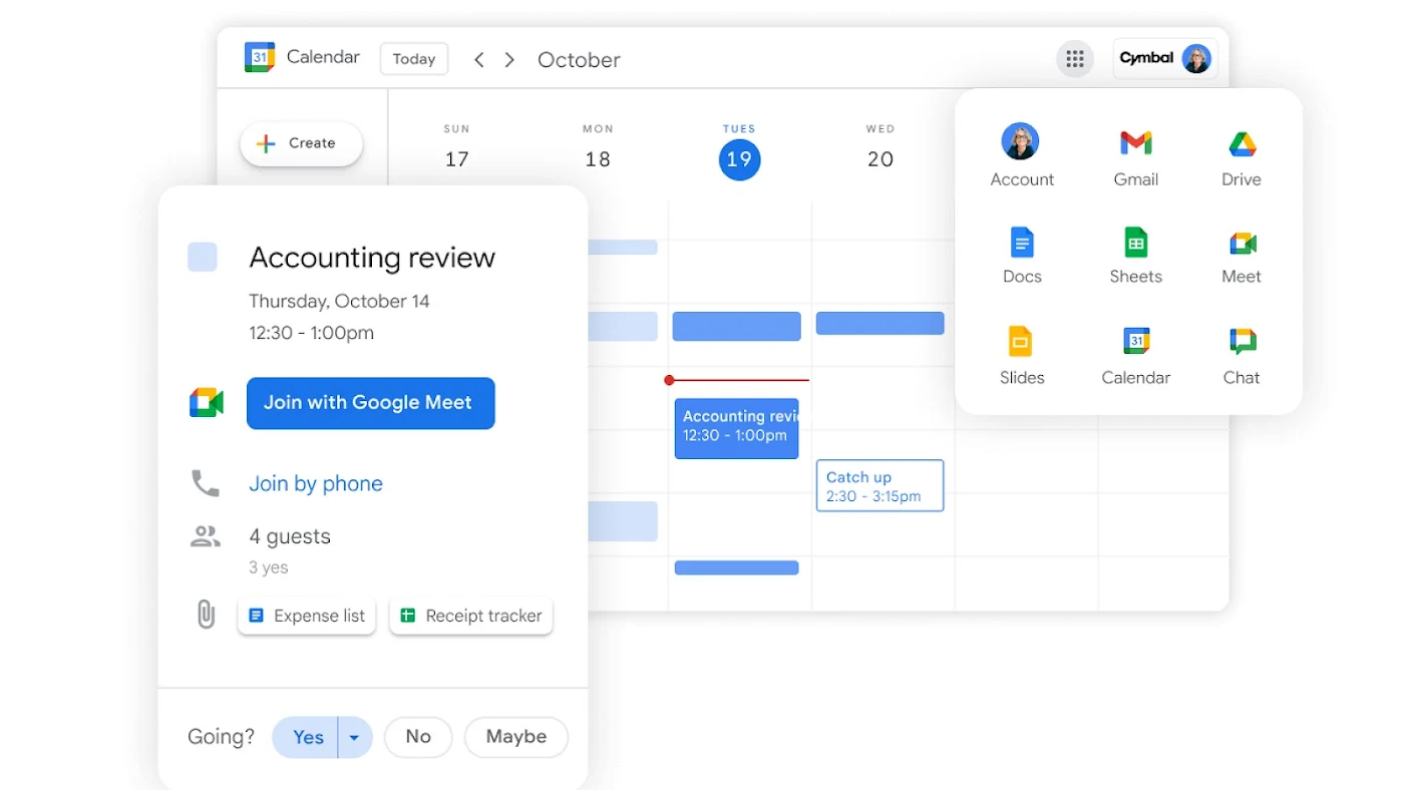 Google Workspace interface.
Google Workspace interface.7. Vibe Canvas
Vibe Canvas is a sophisticated digital whiteboarding software that transforms collaborative work through its intuitive, touch-optimized interface. This platform provides an infinite digital canvas where teams can write, sketch, and ideate together in real-time, regardless of their physical location.
The software excels at visual collaboration with features like lifelike brushes, smart text recognition, and intelligent shape creation. Teams can annotate documents, import files, and collaborate on visual content simultaneously, making complex ideas easier to communicate and develop.
Vibe Canvas integrates seamlessly with popular productivity tools including Google Workspace, Microsoft Office, Zoom, and Slack. This connectivity ensures work created in Canvas flows naturally into your existing workflow. For hybrid teams, it serves as a digital bridge between office and remote workers, enabling everyone to contribute equally regardless of location.
8. Notion
Notion offers a flexible workspace that combines notes, documents, wikis, and project management in a single platform. Its block-based architecture allows teams to build custom workspaces that precisely match their workflows and information needs.
The platform’s database capabilities enable structured information management with customizable views, filters, and sorting options. Teams can create everything from simple to-do lists to complex project trackers, knowledge bases, and team directories. For organizations looking to reduce tool sprawl and create a centralized information hub, Notion provides a versatile foundation that can adapt to evolving needs without requiring constant switching between specialized applications.
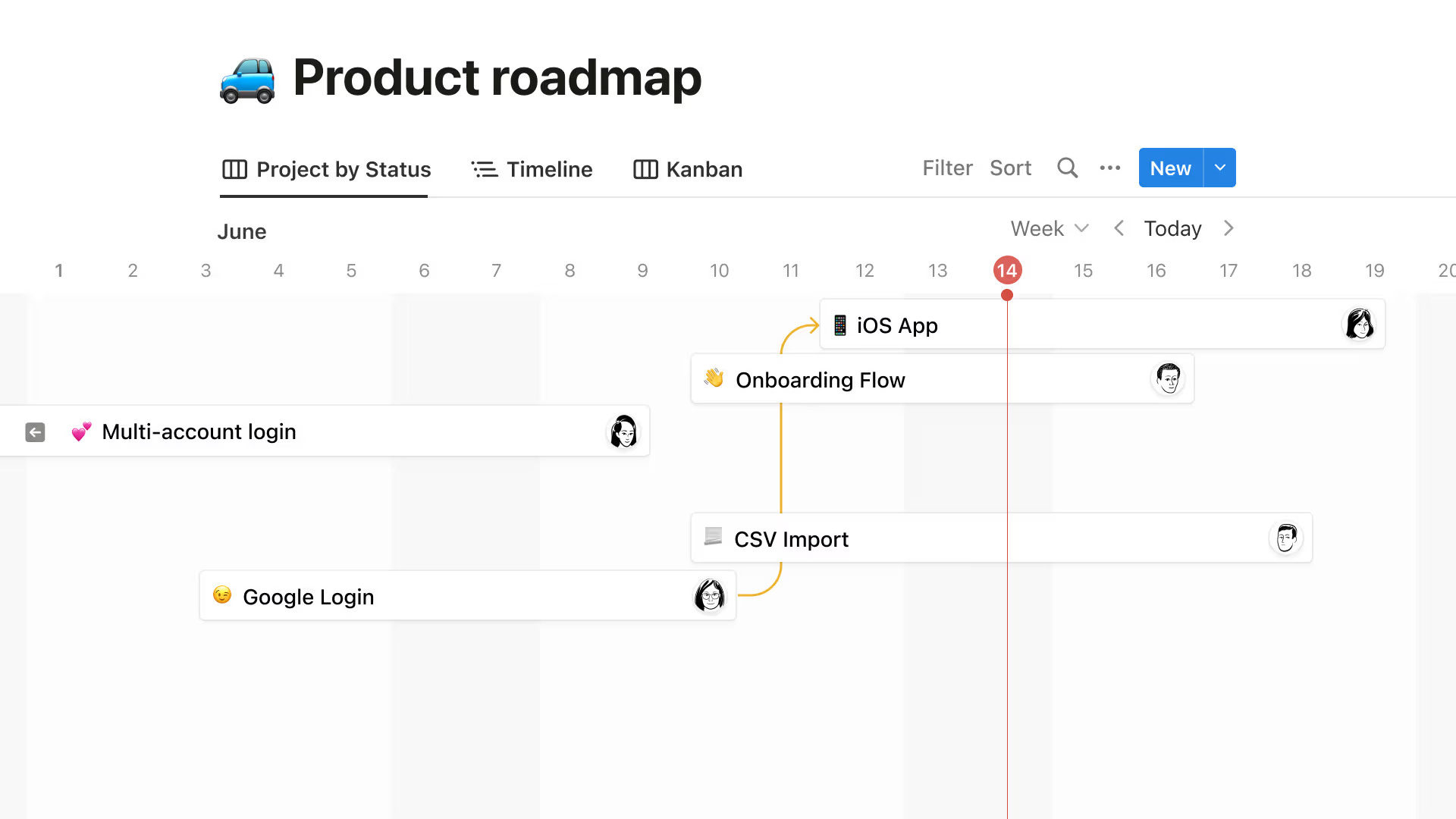 Notion workspace interface.
Notion workspace interface.9. Zoom
While primarily known for video conferencing, Zoom has evolved into a comprehensive collaboration platform with features for chat, phone calls, webinars, and interactive whiteboarding. Its reliable video quality and intuitive interface have made it a staple for remote and hybrid teams.
Beyond basic meetings, Zoom offers capabilities like breakout rooms, polls, and recording that enhance virtual collaboration. The platform’s whiteboard feature allows teams to sketch ideas and annotate shared screens during video calls, adding a visual dimension to remote discussions. Integration with calendar tools and other collaboration platforms ensures that Zoom meetings fit seamlessly into broader workflows, making the transition between asynchronous and synchronous collaboration as smooth as possible.
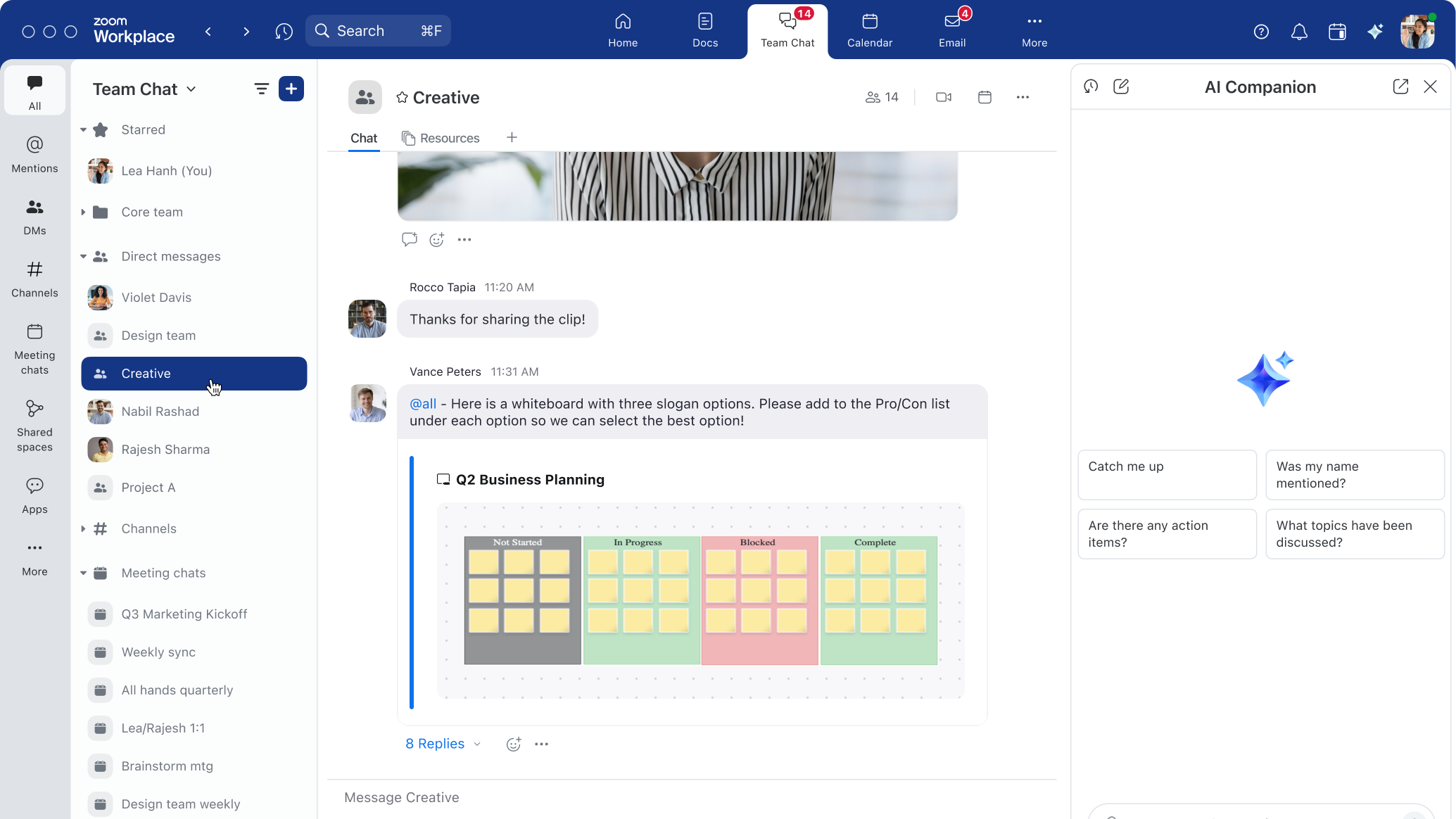 Zoom collaboration platform interface.
Zoom collaboration platform interface.10. Monday.com
Monday.com offers a visual work operating system that helps teams plan, track, and deliver projects of all sizes. Its colorful, intuitive interface uses boards, columns, and automation to create customized workflows for any team or project type.
The platform’s flexibility allows it to support everything from simple task tracking to complex project management, resource allocation, and client work. Features like time tracking, dependencies, and custom notifications ensure that work progresses smoothly and nothing falls through the cracks.
For teams seeking a balance between structure and adaptability, Monday.com provides templates to get started quickly while offering extensive customization options to refine workflows as needs evolve.
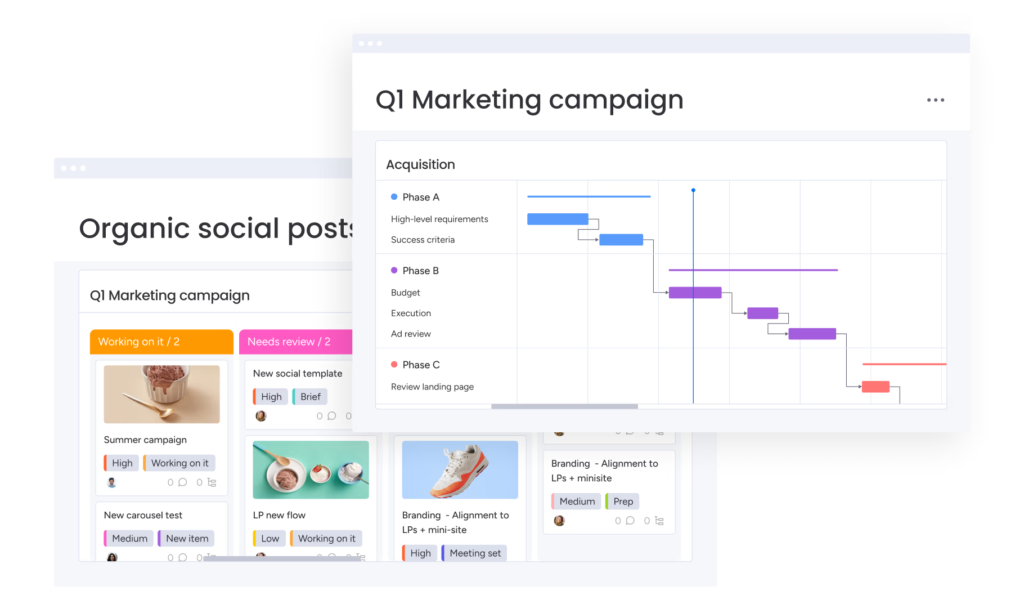 Monday.com collaboration platform interface.
Monday.com collaboration platform interface.Choosing Collaboration Software for Your Team
Selecting the right collaboration tools requires a strategic approach focused on your team’s specific needs and future growth. Start by identifying your core collaboration challenges—whether communication, project management, document sharing, or a combination. This clarity helps target tools that address your most pressing pain points.
Consider your team’s technical comfort level and adoption readiness. Look for intuitive interfaces and good onboarding resources to ensure successful implementation. Evaluate integration capabilities with your existing technology stack to prevent creating new information silos. Also, assess security features, particularly if you handle sensitive information.
Finally, prioritize scalability. Your chosen platforms should accommodate growth in team size and evolving workflows without requiring a complete system overhaul. The right collaboration software doesn’t just facilitate teamwork—it transforms how your team thinks, creates, and achieves together.
Elevate Your Collaboration With The Vibe Board S1
As you implement your collaboration strategy, consider how hardware can amplify the effectiveness of your software tools. The Vibe Board S1 smart whiteboard serves as a physical hub where digital collaboration comes to life, offering the tactile experience of a traditional whiteboard enhanced with advanced digital features.
Vibe Board S1 addresses common collaboration challenges by unifying communication, project management, and document sharing into one seamless platform. With real-time multi-user interaction and integration with over 250 professional apps—including Microsoft Teams, Zoom, and Google Workspace—teams can communicate, manage projects, and share documents without switching between fragmented tools. Instant cloud saving, cross-device accessibility, and direct connections to popular cloud storage services ensure that all collaboration needs are met in a single, secure hub—streamlining workflows and keeping everyone connected, whether in the office or remote.
For hybrid teams, the S1 creates a vital bridge between in-office and remote workers, ensuring equal participation regardless of location. When building your collaboration ecosystem, remember that physical tools like smart whiteboards complement your software choices, creating a complete environment tailored to your team’s unique collaboration style and needs.
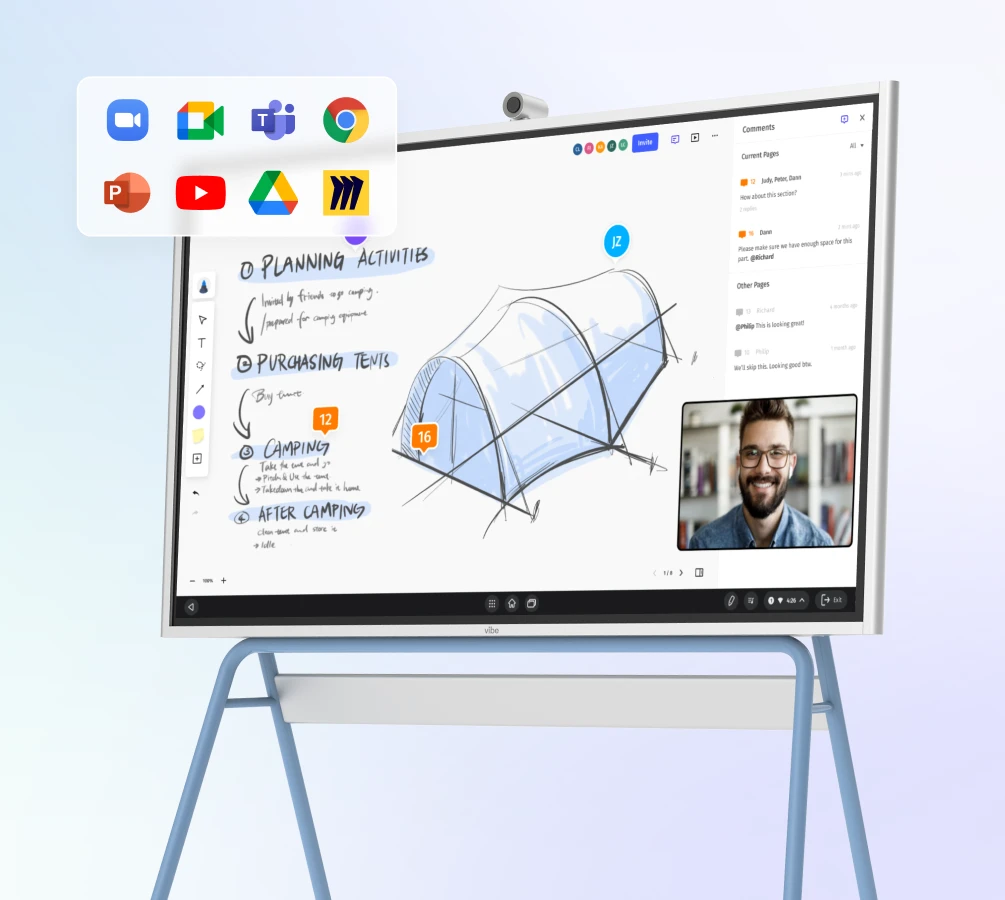 Image of Vibe Board S1.
Image of Vibe Board S1.


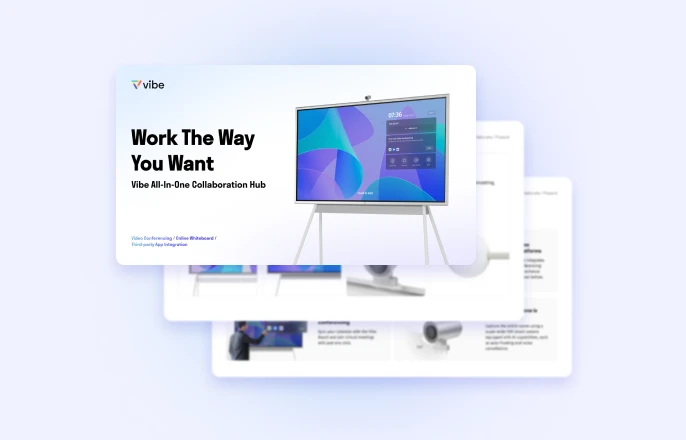
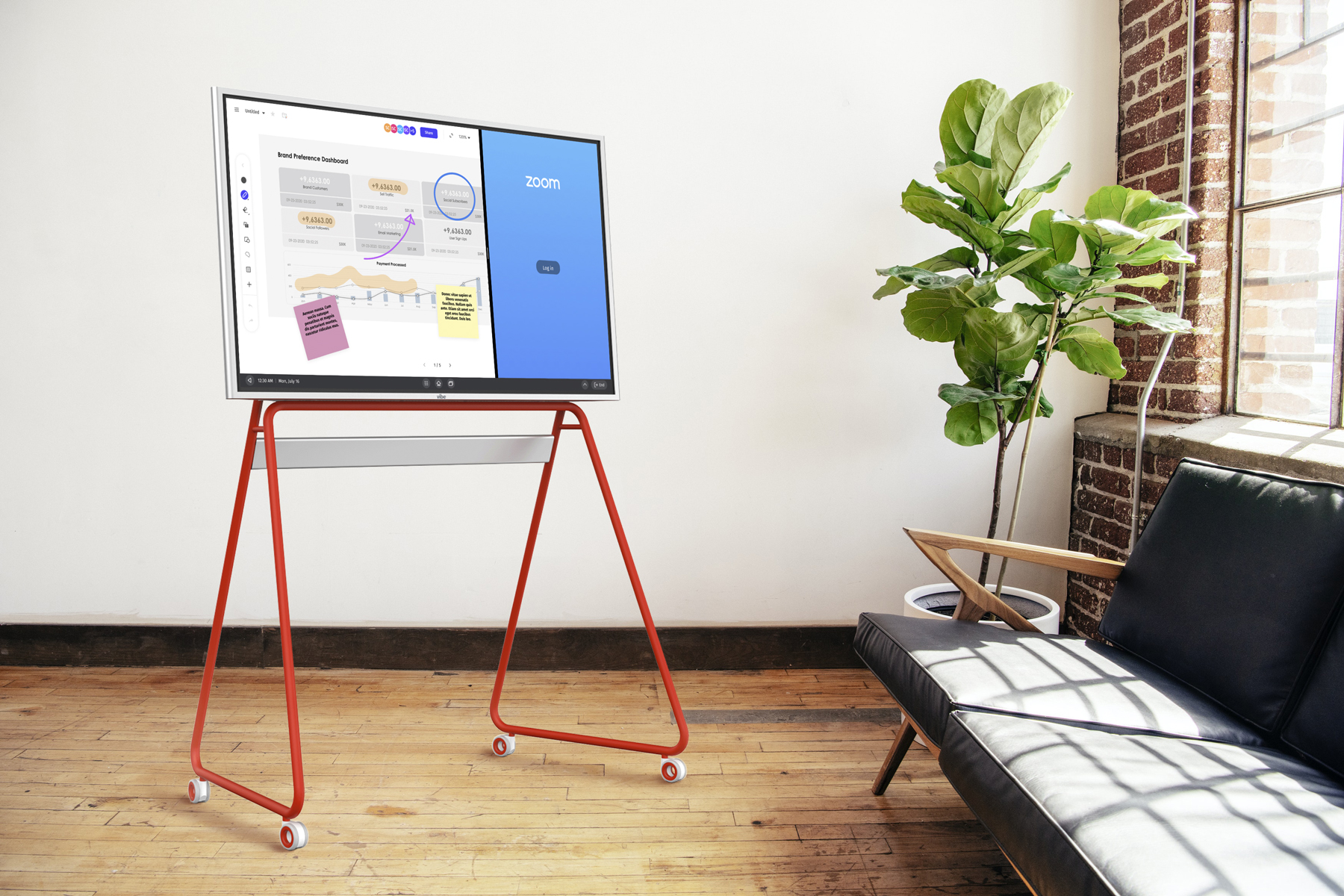



-1sbltxxq4FYxHrXrwJVLsCDNsXpqNa.webp)
-5Zp0pmSytvcuYDVs1LvuwplKuRneK0.webp)
